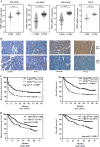Restoration of FBP1 suppressed Snail-induced epithelial to mesenchymal transition in hepatocellular carcinoma
- PMID: 30429463
- PMCID: PMC6235921
- DOI: 10.1038/s41419-018-1165-x
Restoration of FBP1 suppressed Snail-induced epithelial to mesenchymal transition in hepatocellular carcinoma
Abstract
Fructose-1,6-bisphosphatase (FBP1), one of the rate-limiting gluconeogenic enzymes, plays critical roles in several cancers and is treated as a tumour suppressor. However, its role in hepatocellular carcinoma (HCC) is unclear. Here, we demonstrated that FBP1 was significantly inhibited during Snail-induced epithelial to mesenchymal transition (EMT) and tissues in HCC. Restoration of FBP1 expression in HCC cancer cells suppressed EMT phenotype, tumour migration and tumour growth induced by Snail overexpression in SMMC-7721 cells. Gene set enrichment analyses revealed significantly enriched terms, including WNT, Notch, ESC, CSR and PDGF, in the group with high Snail and low FBP1 compared with those with low Snail and high FBP1. Low FBP1 expression was significantly correlated with higher AFP level, satellite nodules, portal vein tumour thrombus, and advanced tumour stage. Survival analyses showed that FBP1 was an independent prognostic factor for overall survival and recurrence-free survival. In conclusion, our study revealed a vital role for FBP1 in Snail-induced EMT and prognostic prediction in HCC.
Conflict of interest statement
The authors declare that they have no conflict of interest.
Figures






References
Publication types
MeSH terms
Substances
LinkOut - more resources
Full Text Sources
Medical
Research Materials
Miscellaneous

